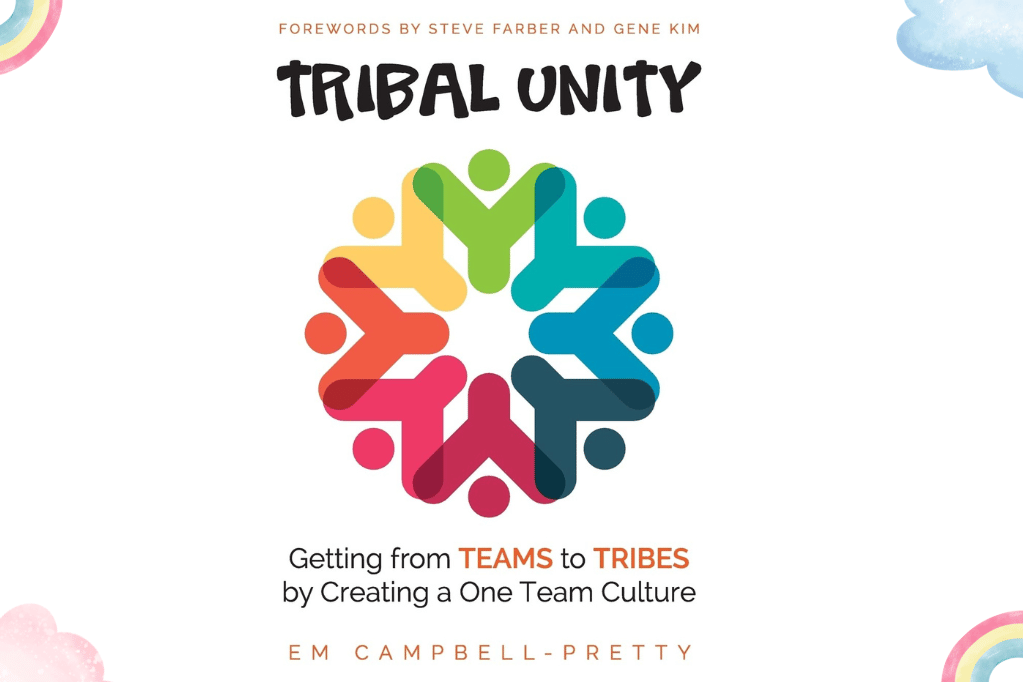Table of Contents
ToggleIf you’re searching for ways to create a happy and collaborative workplace, look no further than Em Campbell-Pretty’s book: Tribal Unity. With real-life experience as a foundation, Campbell-Pretty offers a practical guidebook on building Tribal Unity. She doesn’t claim to introduce a new idea, but instead references various sources that have been successfully applied by her and her team.
Drawing inspiration from David Logan’s Tribal Leadership, Campbell-Pretty simplifies the concept of Tribal Culture as an organization to an Agile Release Train (ART) or Team of Agile team perspective as Tribal Unity. She encourages readers to strive to become Stage 5 tribes for increased productivity. Imagine an ART where everyone feels like family and productivity is off the charts. Currently, only 2% of US organizations have reached this level, with examples like Olympic gold medal teams and Apple Macintosh.
Campbell-Pretty presents the key elements necessary for building effective and motivating tribes. Get ready to feel motivated and energized with your team every single day.
The Agile Release Train (ART) is a long-lived team of Agile teams that incrementally develops, delivers, and often operates one or more solutions in a value stream.
Part 1: Create Great Teams
To establish a culture of oneness, start by allowing team members to self-select into their teams. This method helps ensure that team members have a sense of belonging and ownership over their work. This is done by providing the team members the mission and vision of the product along with clear constraints (e.g., number of people per team, teams need to be co-located, teams must have cross-functional skill sets). Then, leaders allow them to use this information to self-organize.
Implement work practices such as daily communication and inspect and adapt on cadence to support collaboration and continuous improvement, respectively. Visualizing the work and making the vision, dependencies, and blockers clear helps promote alignment and transparency. If any of these work practices are too overwhelming to implement, at the very least make time to conduct the inspect and adapt. There’s nothing worse than expecting the team to improve if they do not take the time to identify areas for improvement and do something to resolve it.
While co-location is ideal, embrace technology to bridge the gap for distributed teams. Communication, collaboration, and delivering exceptional products can still be achieved.

• Daily communication is also known as daily stand-ups or team syncs.
• Inspect and Adapt is also called as sprint retrospective or iteration retrospective.
Part 2: Build Strong Teams and Cultivate Your Tribe
In order to foster a sense of unity within your team of teams, it’s important to create a shared identity and experiences. One way to do this is by using themed team names, such as Rocket Ships or Bird Names. You can also utilize innovative games like “product box” to align the team’s understanding and vision.
In addition, adopting a whole-of-tribe perspective can help bring teams together and emphasize the importance of unity. Chapters and Guilds provide a unique approach, focusing on similar skills and competencies rather than traditional functional teams. In these groups, members don’t have a direct manager, but instead come together to share challenges, learnings, and collaborate on solving common problems within their teams.
Participation in Chapters and Guilds is voluntary, allowing members to join or leave as they wish. And don’t forget to celebrate as a tribe and implement Tribal Kaizen to encourage a continuous search for improvement opportunities.
To further strengthen your tribe, consider organizing events like a unity hour, where everyone synchronizes, or a joint chant like the Haka. Another great idea is to have a breakaway day or sports day, which allows team members to get to know each other beyond their work roles.
Kaizen is a Japanese word that means “change for the better.” It was introduced Taiichi Ohno as part of Toyota’s Production System.
Kaizen is about changing the ways things are. If you assume that things are all right the way they are, you can’t do kaizen! So change something! – Taiichi Ohno
Part 3: Build Connections with Leaders
The vulnerability paradox: It’s the first thing. I look for in you and the last thing I want you to see in me.
—Brené BrownTo truly bring leaders into the team, it’s important for them to also walk the talk. They need to show vulnerability and embrace their humanity. This means being actively involved in the changes and connecting with their team on the ground level.
Simply stating the desire to support and connect with the team isn’t enough. Leaders need to invest time in going to where the work is happening and truly understanding the system. By doing this, they can better relate to their team and become subject matter experts themselves.
The author shares her own experience of joining a tennis-throwing activity and displaying her bad hand-eye coordination. She also shares a bad attempt at the Bus Stop dance move in response to the team’s feedback about her not doing the Macarena dance. This shows vulnerability and breaks down barriers between leaders and their teams, even if it may be challenging or embarrassing for the leader. It can be a powerful tool for fostering stronger connections between leaders and their teams.
Part 4: The Power of Connection
To truly embrace an idea, it’s not enough to simply share the vision and mission. Consistent reinforcement and alignment are key. But what if there’s not enough time to learn and understand new concepts? Campbell-Pretty had a similar challenge with their EDW team. So, they came up with a solution: a book club. By setting aside dedicated time for reading and discussion, they created a space for learning, alignment, and execution of their team’s vision.
When introducing new ideas, it’s natural to encounter opposing views. There will always be both supporters and detractors. Campbell-Pretty has a great approach to handling detractors: observe and listen. They provide evidence of change and stay true to their ideas. By demonstrating the impact, value, and boost in team morale, they show that an idea can make a difference. Having detractors doesn’t mean giving in or compromising. It’s about giving their ideas a fair chance while remaining open to necessary changes.
Part 5: Sustain Tribal Unity: How to Keep Your Team Strong.
…change sticks only when it becomes “the way we do things around here”, when it seeps into the very bloodstream of the work unit…
—John Kotter, Leading Change.Building a strong team and connecting them to a common vision is a great start, but how do you maintain that momentum? This article explores the importance of metrics like NPS and eNPS to gauge customer and employee satisfaction. Sharing team success stories and making them visible to everyone is also key. Additionally, setting up successors for success and maintaining discipline will ensure ongoing success. Learn how to avoid complacency and keep your team thriving in this insightful read.
Part 6: Get Management on Board with Tribal Unity
It is important to remember that management is not the enemy. They want to do a good job just like everyone else. To gain their support, here are some tips from the author:
- Make Tribal Unity relevant to them
- Appeal to their empathy
- Celebrate small victories and involve leaders in the process
- Propose small changes to get things started
One way to change the narrative is by turning to Brené Brown’s book, Rising Strong. Brown explores how the stories we tell ourselves shape our perception of the world. Often, our assumptions about leaders are incorrect or incomplete. To bridge this gap, perform a quick reality check by comparing the stories you tell yourself with the actual situation.
Sometimes proposing something small is the best way to get management to try new things. So, choose an endeavor that you’re almost sure will work. Get agreement to get it done. Once you have a successful implementation, you can leverage your new ticket to play by getting approval for the next small thing.
Build your own Tribal Unity
Implementing these parts may require some time, effort, and patience. However, the benefits of Tribal Unity are invaluable. By fostering a sense of belonging, shared vision, and consistently reinforcing this mindset, you can establish and uphold a culture of unity within your team. Take the first step towards building your team’s Tribal Unity today!
Don’t forget to check out our review of A Sense of Urgency.


